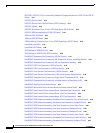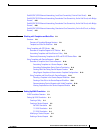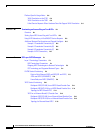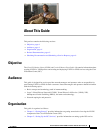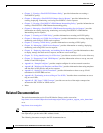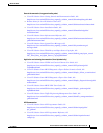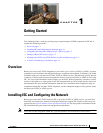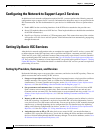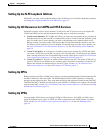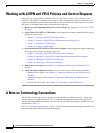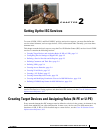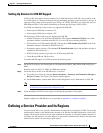
1-2
Cisco IP Solution Center L2VPN and Carrier Ethernet User Guide, 6.0
OL-21636-01
Chapter 1 Getting Started
Configuring the Network to Support Layer 2 Services
Configuring the Network to Support Layer 2 Services
In addition to basic network configuration required for ISC, you must perform the following network
configuration steps to support Layer 2 services. Information on doing these steps is not provided in the
ISC documentation. See the documentation for your devices for information on how to perform these
steps.
1. Enable MPLS on the core-facing interfaces of the N-PE devices attached to the provider core.
2. Set up /32 loopback addresses on N-PE devices. These loopback addresses should be the termination
of the LDP connection(s).
3. Set all Layer 2 devices (switches) to VTP transparent mode. This ensures that none of the switches
will operate as VLAN servers and will prevent VLAN information from automatically propagating
through the network.
Setting Up Basic ISC Services
After the basic network configuration tasks are completed to support ISC and L2 services, you use ISC
to define elements in the ISC repository, such as providers and regions, customers and sites, devices,
VLAN and VC pools, NPCs, and other resources that are necessary to provision L2 services. Detailed
steps to perform general ISC tasks are covered in the
Cisco IP Solution Center Infrastructure Reference,
6.0. You can also find a summary of some important ISC set up tasks in this guide in Chapter 2, “Setting
Up the ISC Services.” The information below is a checklist of basic ISC services you must set up before
provisioning L2 services.
Setting Up Providers, Customers, and Devices
Perform the following steps to set up providers, customers, and devices in the ISC repository. These are
global resources that can be used by all ISC services.
1. Set up service providers and regions. The region is important because a single provider could have
multiple networks. The region is used as a further level of differentiation to allow for such
circumstances. To create a provider and a region, see the
Cisco IP Solution Center Infrastructure
Reference, 6.0. See also Defining a Service Provider and Its Regions, page 2-3.
2. Set up customers and customer sites. A customer is a requestor of a VPN service from an ISP.
Each customer can own many customer sites. Each customer site belongs to one and only one
Customer and can own many CEs. For detailed steps to create customers and sites, see the
Cisco IP
Solution Center Infrastructure Reference, 6.0. See also Defining Customers and Their Sites,
page 2-4.
3. Import or add raw devices. Every network element that ISC manages must be defined as a device
in the ISC repository. An element is any device from which ISC can collect information. In most
cases, devices are Cisco IOS routers and switches. You can set up devices in ISC manually, through
autodiscovery, or through importing device configuration files. For detailed steps for importing,
adding, and collecting configurations for devices, see the
Cisco IP Solution Center Infrastructure
Reference, 6.0. See also Chapter 12, “Using Autodiscovery for L2 Services.”
4. Assign devices roles as PE or CE. After devices are created in ISC, you must define them as
customer (CE) or provider (PE) devices. You do this by editing the device attributes on individual
devices or in batch editing through the ISC inventory manager. To set device attributes, see the
Cisco
IP Solution Center Infrastructure Reference, 6.0.



